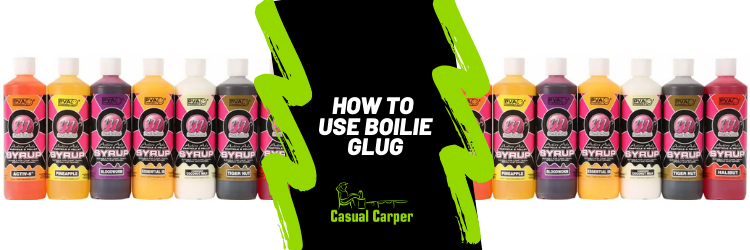
For me, boilie glugs are an essential part of my carp fishing. I use them to boost spod mixes, particles and to glug hook baits. They’re an essential part of my awesome winter mix (crushed and crumbed boilies that are heavily glugged) and I hone the mix in the summer to keep the effectiveness but add more food sources and visual stimulants to it.
How to Glug boilies
Here’s how I glug my shelf life boilies for added attraction. This is something I do all year round to give them an added attraction. In the summer months, they will all get a light coat of glug and in the winter I’ll use a heavier coat or dip to boost boilies and hook baits. (scroll down for my dip tips).
This mix should be prepared roughly 24 to 48 hours before your trip. In the winter I have a bucket of crumbed boilies on the go for months and just keep topping it up when needed.
Step 1 – What you’ll need
Grab your boilies! The example below shows my Salted Caramel Nut boilies with a matching glug. This is a potent combination when mixed together and has bagged me loads of carp using this exact mix. These are hgh quality boilies that I sell in my online store. They are perfect for glugging and crumbling down.
- Shelf Life boilies
- Matching boilie glug
- A large mixing bowl and spatula
I’d recommend starting with 1kg of bait and seeing how you get on with the mix, you’ll want the bait to roughly half fill the bowl. You don’t need to use a matching glug if you’d prefer to mix it up you can vary it, or use 2 different flavours.
To give an extra edge in summer I often add around 10% of the boilies which have a different colour to make it more visual. For the mix the better quality the boilies the better. This is all about maximising the flavour from both the bait and the glug.
Step 2 – The base mix
To start with we’re looking to just get a nice coating on all the bait so start with a small amount of glug, around 50ml – roughly 10% of the bottle. Then mix them around the bowl using the spatula to make sure the liquid doesn’t stick to the sides of the bowl too much. Lightly mix them around until you can see they all have the liquid coating the baits.
If you just want an extra boost to your boilies then you are done now. Put them in a tub or bag and leave them until you are ready to go to the bank, or read on for extra additives. If you are leaving them for a while give them a regular shake to keep the distribution of the glug around the baits.
Step 3 – Additives
If you want an extra boost there are a few other options available to you, that I like to use to mix it up at times.
- Use boilie crumb in the mix – This is one of my favourite mixes. You need to use a smaller amount of boilies and a higher concentration of glug. For this, you need to get the boilies really well coated in the liquid and then leave them for around 24 hours. Then get some boilies in the grinder (I use this one from NGT – here)and grind them down to a fine crumb. Add this to your glugged boilies and the crumb will stick to the outside giving you a coated boilie that’s packed with attraction and will stand out against other people fishing with standard baits.
For the above mix a 1KG bag of boilies and split them roughly in 3. Break a third of the boilies in half, roughly break up another third of the boilies and then fine crumb the other third.
Take all the halved and roughly broken boilies and half of the crumb and heavily glug it so it’s sticky. Then leave it overnight.
The next day when you head to the bank add the rest of the crumb to absorb any of the extra liquid. This is a great mix for the winter months. For the warmer months reduce the amount of crumb if there are coarse fish in the lake.
- Use additional liquids – You can easily add other liquids to the mix for variety and oils work very well in the summer months.
- Add other feeding stimulates – Mix in a few other boilies from a different flavour and colour to visually stimulate the carp. As the weather gets towards spring start adding more boilies and possibly some sweet corn to the mix.
- Mix with particles – If you are using a crumb and broken boilie mix then add in some particles for a feast of colours, flavours and attractants.
Glugged boilie crumb also makes an excellent addition to solid bags. Rather than filling them with pellets, you can crumb your boilies down to almost powder and then fill your bags with them. Make sure you make around what you need is it does take a considerable amount of glug to soak into the crumb. This then creates a cloud of attraction around your hook bait to attract the fish in with.
How to make coated boilies
This is a way to use glug for a real edge to your fishing and it’s not a tactic that is used by many. To start with glug your boilies or hook baits for a couple of days and make sure to keep shaking them to get them fully covered in glug. Then drain the liquid off them and leave them for a couple of days in an airtight container.
When they have a sticky outer coat add some finely crumbed boilies to the mix and give them a good shake to get the boilies coated. Then leave them for a further couple of days for the crumb to stick up to the outside. This gives a very quick attraction to your baits as soon as they go in the water.
How to glug hook baits
I’m also a fan of adding glug to my hook baits such as popups and balanced wafters. You’ll need to take into account any liquids they take on will reduce their buoyancy.
To start with, take a pot of your hook baits and cover them in the glug.
I’d generally leave them like this for a few days and then drain the liquid off which over time will leave them sticky with an added attraction. Again you can add a crumb coating at this point. If you are not fishing with them for long periods of time and don’t mind a loss of buoyancy then you can leave them in the liquid indefinitely. If you are doing this then it is advisable to give them a shake every now and again to keep re-coating them to avoid them drying out on top if they are out of the liquid.
This is what I do with my wafters to give them a real kick but allow them to stay light enough to fly up into the carps mouth when eaten.
How to use a boilie dip
Boilie dips are a great way to boost your baits just before the cast and my range of glugs can be used for just this. Take a smaller container, I usually use an old lid for single hook baits, and fill it with glug. Just drop your hook bait in before you cast for a quickly added boost to your hook bait. I usually have my next rig tied up and ready to go on the bank so just leave the bait in the dip until I’m ready to use it.
I really like this sweetcorn one from Ourons – See it here. In the summer it can work well fishing a trimmed yellow wafter alongside sweetcorn with the hook baits dipped like this.
Again you can do this with oils in the summer months or the beta stim liquid. These can also be used to add potent flavour to bread when you are surface fishing too.
FAQS
How long do glugged boilies last?
If they are shelf-life boilies in a sealed container they should easily last a month or more, it’s best to just keep an eye on them. Store in a cool dry place out of direct sunlight. Give them a shake regularly to keep them covered in glug.
If they are hook baits in a sealed pot then they will last for months without a problem as long as you store them in a cool dry place out of direct sunlight (as you should even if they’re not glugged).

Hi mate, I have enjoyed your blog. I’m new to the carp fishing scene and have learnt lots from reading it.
I have noticed that you always mention glug using the matching flavour of glug.
Wondering your thoughts of using similar but not ‘matching’?
For example Savoury glug with savoury bait or sweet and creamy glug with sweet and creamy bait.
Thank you Brendan, glad it has helped you